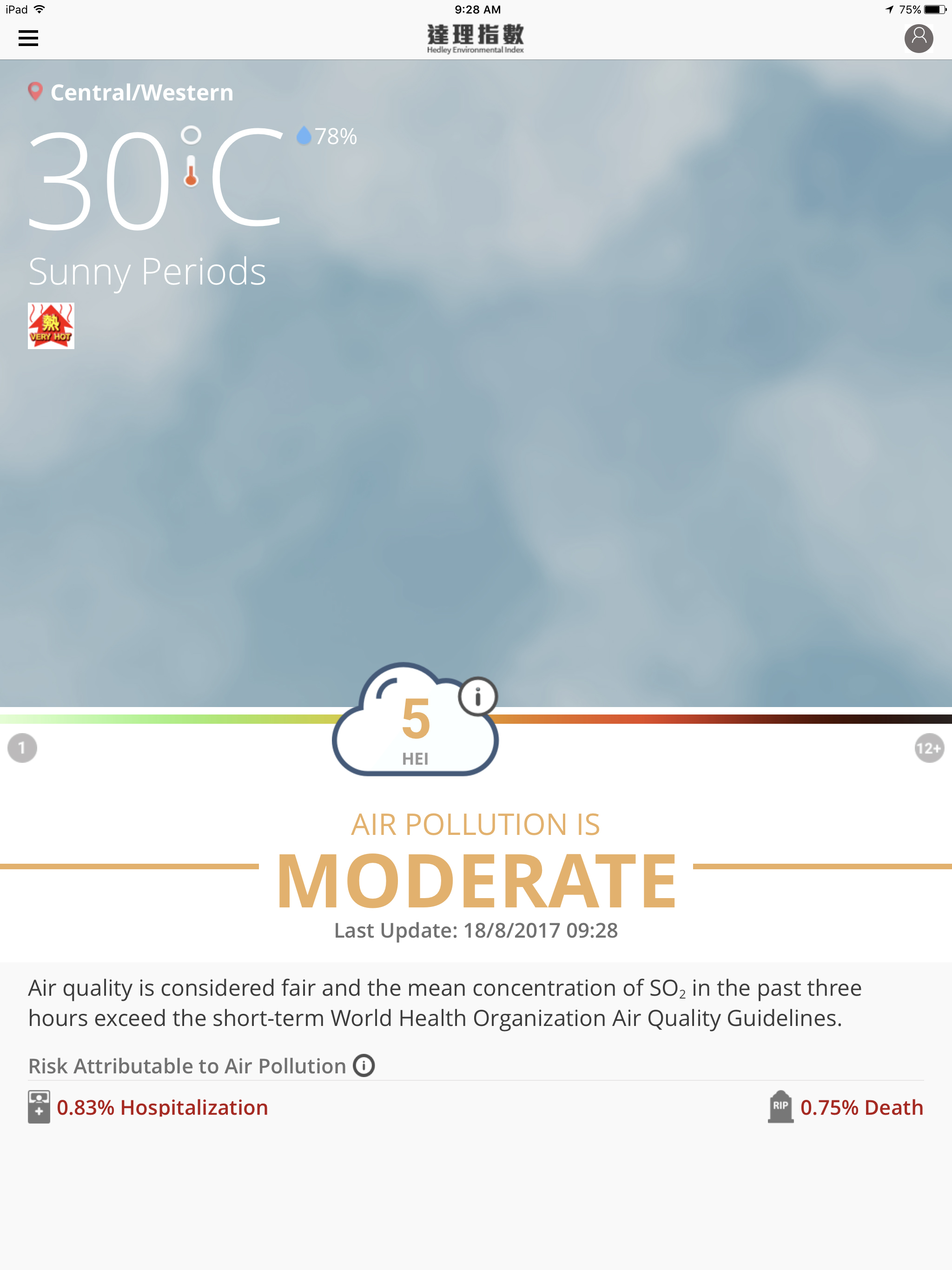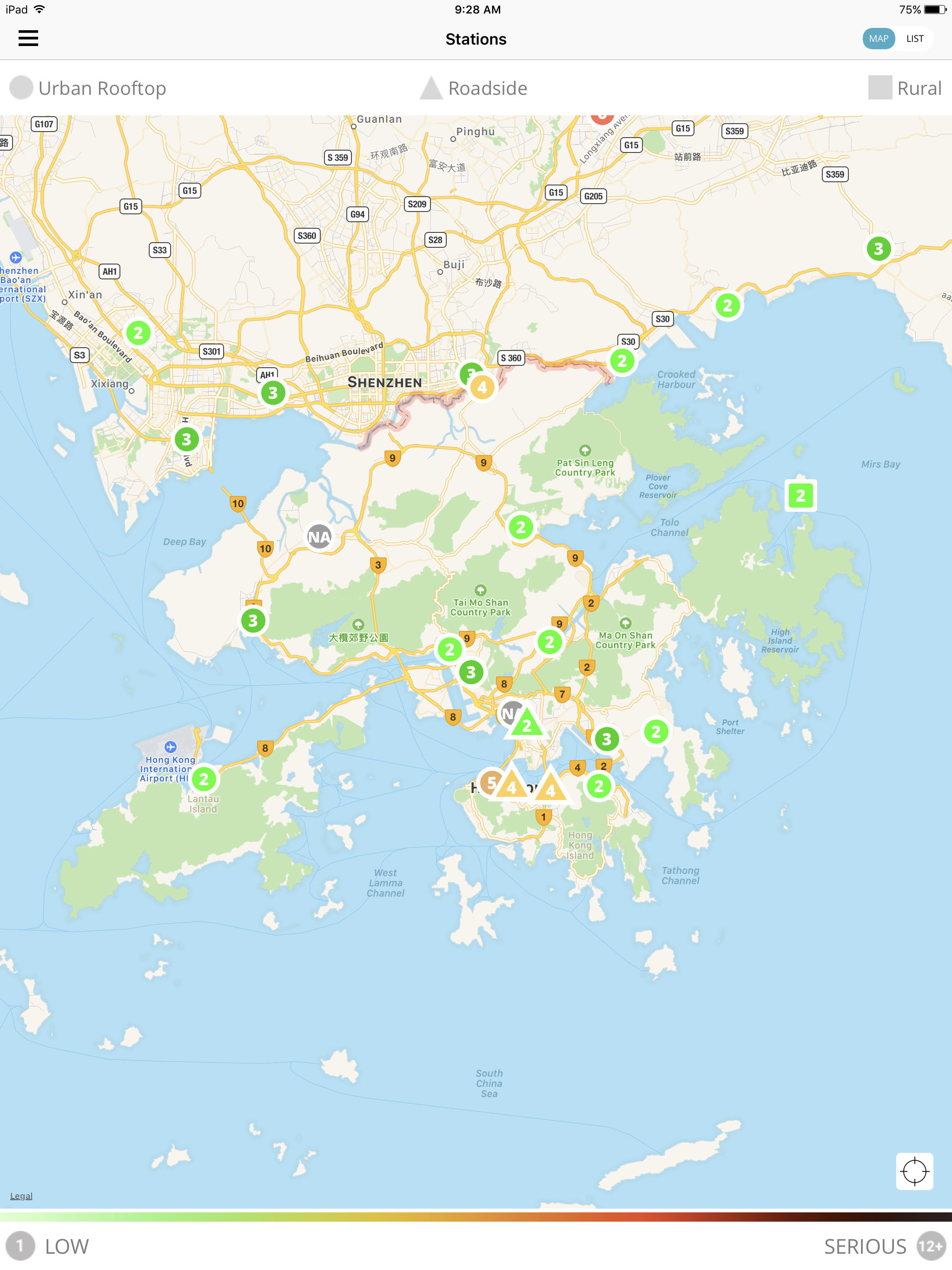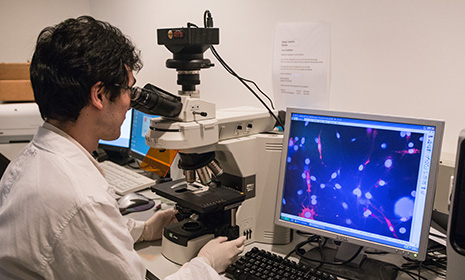HKU School of Public Health Launches New Version of Hedley Environmental Index Better Inform and Assist the Public to Interpret Air Pollution Levels
According to the World Health Organization (WHO) Air Quality Guidelines (AQG), the outdoor air quality of Hong Kong has been considered poor, in particular levels of particulate matters (PM2.5and PM10) exceededWHO guidelines by more than 100% in 2016. Air pollution presents a serious daily threat to the health of the public and for future generations.
To provide an effective approach to health risk communication and to inform and assist the public in the interpretation of pollution levels, a group of researchers inthe School of Public Health at The University of Hong Kong has developed the Hedley Environmental Index (HEI) in 2008 and followed by updates in 2012and 2014, respectively.In an effort to better quantifythe hazard associated with pollution levels in Hong Kong, HKUrecently launched the fourth updated version of the HEI. This new HEI is based on the latest scientific evidence for health risks and referenced to the WHOAQG with a new approach toaggregateair pollutants. The details of this new approach have been published in the latest issue of the International Journal of Hygiene and Environmental Health.
New mobile app of the HEI
The new version of the HEI is launched with the aim of enhancing health risk communication and to better inform and assist members of the public in the interpretation of air pollution levels. The mobile app of HEIoffers features including:
- Individual profile: An individual profile for different age groups, genders and existing cardio-pulmonaryconditions could be preset on the app to quantify the individual hospitalisation and mortality risks attributable to the current level of air pollutants.
- Real-time air quality: Report air pollutants that exceed the WHO AQG and the real-time hourly HEI at users’ current location and for each individual air quality station (13 urban rooftop and 3 roadside air quality stations in Hong Kong, and 11 stations in Shenzhen.)
- Map of air quality: A real-time pollution map showing the levels of the criteria pollutants (particulates, nitrogen dioxide, sulphur dioxide and ozone) for the 16 and 11 air quality stations in Hong Kong and Shenzhen, respectively.
To download the mobile app, please follow the relevant links below:
- Android: https://goo.gl/YfUEwr
- iOS: https://goo.gl/ofGGXk
New HEI website
The new HEI website (http://hedleyindex.hku.hk) comprises new features and modifications including:
- A new aggregating method for the air quality index: A real-time air quality index with 5 categories based on WHO guidelines for the whole territory of Hong Kong and for each individual air quality stations.
- Hong Kong map of real-time air quality: A newly designed Hong Kong real-time pollution map showing the levels of the criteria pollutants for 16 air quality stations.A visual representation of pollution levels by colours, spatial distribution and numerical values provide an instant overall picture of the air quality.
- Rolling clocks of avoidable harm and economic cost to the community: A new graphical display of the recent harm to the community health in terms of doctor visits, hospital admissions and deaths. Rolling metres counting the hourly dollar cost of the pollution impact on health care and lost productivity, and the population willingness to pay to avoid a day’s illness, hospital admission and death.
- Calendar of high pollution days: A summary report showing the number of clear and polluted days the publichave been exposed to so far, using the WHO guidelines as reference.
- Historical data:A newly designed user-friendly interactive graph for viewing the historical data of air pollutants and health burdens, as well as new graphical displays of the past 48-hour trends for the five pollutants.
- Education section:A set of newly produced educational videos on air pollutionin animation in English, Cantonese and Putonghua, and a list of recent publications and news on air pollution.
The study was led by Dr Thach Thuan-Quoc, Scientific Officer and Honorary Assistant Professor of School of Public Health, Li KaShing Faculty of Medicine, HKU. S. H. Ho Foundation Limited is the funder of thelatestversion of HEI development.
About the School of Public Health, Li Ka Shing Faculty of Medicine, HKU
The School of Public Health, Li Ka Shing Faculty of Medicine of The University of Hong Kong has a long and distinguished history in public health education and high impact research. With world leading research in infectious diseases as well as on non-communicable diseases of both local and global importance, the School has made significant contributions through its research and advocacy to improve the health of populations and individuals, both locally and globally. The School is a leading research and teaching hub in public health on influenza and other emerging viruses, control of infectious and non-communicable diseases, tobacco control, air pollution, psycho-oncology, behavioral sciences, exercise science, life-course epidemiology, and health economics, health services planning and management. This work has informed international (e.g. the World Health Organisation, Food and Agriculture Organisation of the United Nations), national and local public health policies.
Media enquiries
Please contact Ms Hilda Tsang (Tel: 3917 9902)of the School of Public Health, Ms Florence Cheng (Tel: 3917 9995 / 9107 1676)or Ms Evelyn Chan(Tel: 3917 9244/ 9131 2820)of Li Ka Shing Faculty of Medicine, The University of Hong Kong.
Please visit the website at http://www.med.hku.hk/news/ for press photos.

The new version of the Hedley Environmental Index shows the real-time pollution levels, as well as the levels of the criteria pollutants, including particulates, nitrogen dioxide, sulphur dioxide and ozone.

User can obtain the real-time hourly Hedley Environmental Index at users’ current location and for each individual air quality station, including the air pollutants that exceed the World Health Organization (WHO) Air Quality Guidelines (AQG).

The locations of the 13 urban rooftop and 3 roadside air quality stations in Hong Kong, and 11 stations in Shenzhen.








.png)
